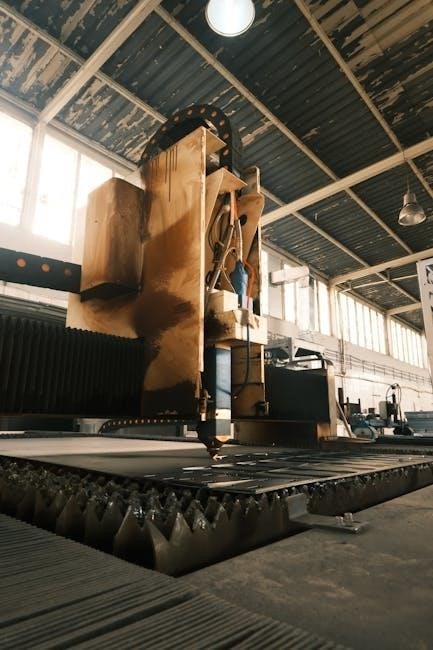Overview of Modern Welding 12th Edition
Modern Welding, 12th Edition, is a comprehensive textbook. It’s a standard for teaching welding theory, fundamentals, equipment, and techniques of welding technology. This edition provides thorough coverage of common welding processes.
Comprehensive Welding Technology Textbook
Modern Welding, 12th Edition, stands as a comprehensive and essential resource in the field of welding technology. This textbook is designed to provide a complete understanding of the theory, fundamentals, equipment, and techniques used in modern welding practices. It thoroughly covers various welding and cutting processes, including gas tungsten arc welding, gas metal arc welding, shielded metal arc welding, and more. Furthermore, it delves into essential areas such as welding symbols, testing and inspection methods, and career opportunities within the welding industry.
The 12th Edition has been updated to reflect advancements in welding technology, ensuring students and professionals have access to the most current information. It is a valuable tool for anyone seeking a solid foundation in welding.

Authors and Publication Details
The 12th Edition of Modern Welding is published by Goodheart-Willcox Company. It’s authored by Andrew D. Althouse, Carl H. Turnquist, and William A. Bowditch. The publication date is 2020, in Tinley Park, IL.
Andrew D. Althouse and Goodheart-Willcox Company
Modern Welding, in its 12th Edition, owes its comprehensive nature to the expertise of Andrew D. Althouse. Althouse served as a Technical-Vocational Education Consultant. He was also a member of the American Welding Society. His contributions were pivotal in shaping the textbook’s content. The Goodheart-Willcox Company, Inc., based in Tinley Park, Illinois, served as the publisher, ensuring the book’s widespread availability and quality production.
Carl H. Turnquist and William A. Bowditch also contributed. Turnquist and Bowditch were both Career Education Consultants. Their experience enriched the text with practical insights. Goodheart-Willcox’s dedication to educational resources is evident in the thoroughness and clarity of this 12th Edition. The book’s success as a standard in welding education is a testament to the author’s and publisher’s combined efforts.
Core Content Areas
The 12th Edition covers safety, print reading, welding joints, positions, symbols, and cutting. It covers ferrous and non-ferrous metals. It is a comprehensive guide to welding.
Welding Theory and Fundamentals
Modern Welding, 12th Edition, delves deeply into the theoretical underpinnings of welding. It explores the fundamental principles governing various welding processes. This includes understanding heat transfer, metallurgy, and the behavior of materials under extreme temperatures. The text elucidates the science behind creating strong and durable welds. It covers the effects of different welding parameters on weld quality and mechanical properties. Students learn about the importance of proper joint design and preparation. Furthermore, it provides a solid foundation in understanding the properties of different metals and alloys. These properties influence their weldability. It emphasizes safety protocols and best practices for a safe and effective welding environment. The book also details the importance of selecting the correct welding process and parameters for specific applications. This ensures optimal weld quality and structural integrity. The reader also gains knowledge of the impact of welding on material microstructure and the resulting mechanical properties. It includes understanding the principles of heat treatment and stress relief to improve weld performance.
Welding Equipment
The Modern Welding 12th Edition provides a comprehensive guide to welding equipment. It covers everything from basic hand tools to automated welding systems. The book meticulously describes the function, operation, and maintenance of various welding machines. This includes power sources, wire feeders, gas regulators, and torches. Detailed explanations of different welding equipment types, like SMAW, GMAW, GTAW, are provided. Safety features and proper usage protocols for each piece of equipment are emphasized. This ensures a secure working environment. Furthermore, the text addresses the selection of appropriate equipment. It provides guidance for specific welding applications and materials. Modern Welding also offers insights into troubleshooting common equipment malfunctions. It covers repair procedures to minimize downtime. The section on welding equipment also includes information on advanced technologies. These technologies cover robotic welding and automated welding systems. This gives the reader a glimpse into modern industrial practices; This complete coverage ensures that students and professionals can select, operate, and maintain welding equipment safely and effectively.
Welding Techniques
Modern Welding 12th Edition offers a detailed exploration of various welding techniques. It covers essential skills for joining metals effectively. The text thoroughly explains techniques for different welding processes, including SMAW, GMAW, and GTAW. It provides step-by-step instructions and visual aids to enhance understanding. Emphasis is placed on proper joint preparation, electrode selection, and welding parameter settings. Students learn to control heat input, bead placement, and travel speed to achieve optimal weld quality. The book covers techniques for different welding positions: flat, horizontal, vertical, and overhead. Troubleshooting tips are included to address common welding defects, such as porosity and undercut. Advanced techniques, like pulsed welding and short-circuit transfer, are also explored. Practical exercises and real-world examples reinforce learning. The section on welding techniques also emphasizes safety. It highlights the importance of personal protective equipment and safe work practices. It guides readers in mastering the art and science of welding. It gives them the ability to produce strong, reliable welds in various applications. This comprehensive approach makes the book an invaluable resource.

Welding and Cutting Processes Covered
This edition covers common welding and cutting processes, including gas tungsten arc welding, gas metal arc welding, flux-cored arc welding, shielded metal arc welding, oxyfuel gas welding and cutting, plasma arc cutting.
Gas Tungsten Arc Welding (GTAW)
Gas Tungsten Arc Welding, commonly known as GTAW or TIG welding, is a precise arc welding process utilizing a non-consumable tungsten electrode to produce the weld. The weld area is shielded from atmospheric contamination by an inert shielding gas such as argon or helium. This shielding gas protects the weld pool and the electrode from oxidation. GTAW is particularly well-suited for welding thin materials and non-ferrous metals like aluminum, magnesium, and stainless steel.
The process allows for very controlled heat input, making it ideal for applications where high weld quality and precision are paramount. GTAW can be performed with or without filler metal, depending on the specific requirements of the weld joint. The operator feeds filler metal manually. This is a highly versatile welding process, capable of producing clean, high-quality welds in various positions and on a wide range of materials. It requires skilled welders.
Gas Metal Arc Welding (GMAW)
Gas Metal Arc Welding, also known as GMAW or MIG welding, is an arc welding process in which a continuous solid wire electrode is fed through a welding gun and into the weld pool. A shielding gas, typically a mixture of argon and carbon dioxide, protects the weld area from atmospheric contamination. GMAW is a versatile and efficient welding process suitable for a wide range of materials, including steel, aluminum, and stainless steel.
The process is relatively easy to learn and can be automated for high-volume production. GMAW offers high deposition rates and good weld quality, making it a popular choice for many fabrication and manufacturing applications. Several variations of GMAW, such as pulsed GMAW and short-circuit GMAW, are available to optimize the process for specific materials and welding conditions. The continuous wire feed allows for long, uninterrupted welds. It’s widely used.
Shielded Metal Arc Welding (SMAW)
Shielded Metal Arc Welding, commonly known as SMAW or stick welding, is a manual arc welding process that uses a consumable electrode covered in a flux to create the weld. An electric current, either alternating current (AC) or direct current (DC), is used to form an electric arc between the electrode and the base metal, melting both the electrode and the base metal to create a molten pool that solidifies to form the weld joint. The flux coating on the electrode melts during welding. It forms a shielding gas that protects the weld area from atmospheric contamination and a slag layer that covers the weld bead.
SMAW is versatile. Suitable for various metals. It can be used in different positions. It is one of the most widely used welding processes due to its simplicity, portability, and cost-effectiveness.

Additional Topics
Beyond the core welding processes, Modern Welding, 12th Edition, delves into crucial related areas. These topics include welding symbols for effective communication, and methods for testing and inspecting welds to ensure quality and safety.
Welding Symbols
Modern Welding, 12th Edition, provides thorough coverage of welding symbols, essential for effective communication on engineering drawings. These symbols are a standardized language that clearly conveys weld specifications to fabricators and inspectors. Understanding welding symbols is crucial for interpreting blueprints and ensuring welds meet design requirements. The textbook details how to interpret and apply these symbols, covering weld type, size, location, and other supplementary information. Correct interpretation of these symbols prevents errors in fabrication, leading to stronger, safer, and more reliable welded structures. Detailed explanations and examples in Modern Welding guide students through this complex system, improving their ability to communicate effectively in the welding industry. This section ensures that students gain the skills to accurately read and understand welding symbols, a vital component of any welding project. Mastering welding symbols is essential for career success.
Testing and Inspecting Welds
Modern Welding, 12th Edition, dedicates a significant portion to testing and inspecting welds, vital for quality assurance. This section covers various destructive and non-destructive testing methods used to evaluate weld integrity. Destructive tests, like tensile and bend tests, assess the mechanical properties of the weld. Non-destructive tests, such as visual inspection, radiographic testing, and ultrasonic testing, detect surface and subsurface flaws without damaging the weld. The textbook explains the principles behind each testing method, detailing their advantages and limitations. Proper weld inspection ensures that welds meet required standards and specifications, preventing failures and ensuring structural integrity. Modern Welding guides students through the process of identifying common weld defects and interpreting test results. This knowledge is crucial for welders, inspectors, and engineers involved in welding projects. Understanding testing and inspection enhances safety and reliability.

Career Information
Modern Welding, 12th Edition includes a section that guides students toward welding industry jobs. It covers resume writing, interview skills, and navigating the job market for welding-related professions and also lists common welding jobs;
Getting a Job in the Welding Industry
The Modern Welding, 12th Edition, dedicates a section to “Getting a Job in the Welding Industry.” This crucial part of the text assists students in transitioning from their welding education to professional careers. It offers practical advice on various aspects of job searching, including crafting effective resumes and cover letters that highlight relevant skills and experience.
Furthermore, the text provides guidance on preparing for job interviews, including common interview questions and strategies for showcasing welding expertise and problem-solving abilities. It also covers networking techniques, exploring different career paths within the welding field, and understanding industry trends. This part of the book is designed to give aspiring welders the knowledge and confidence they need to succeed in their job search and launch successful careers.
